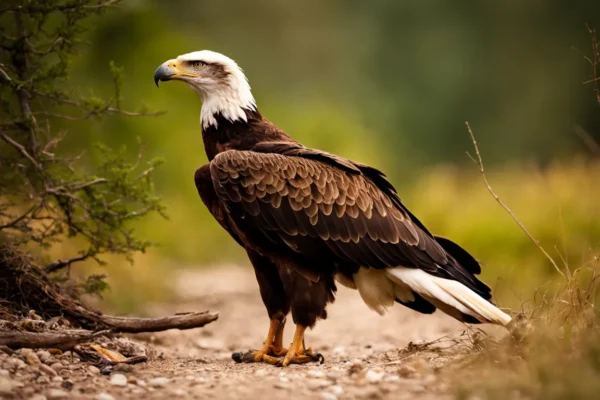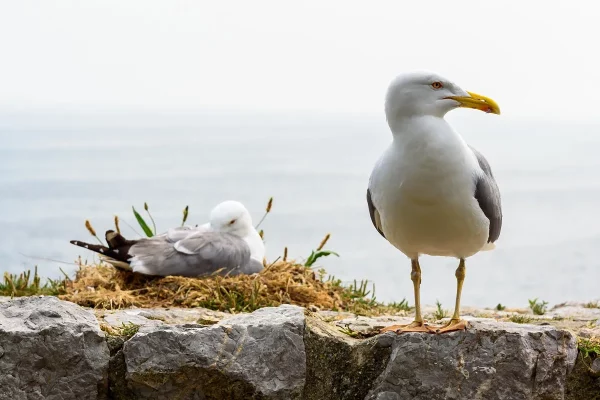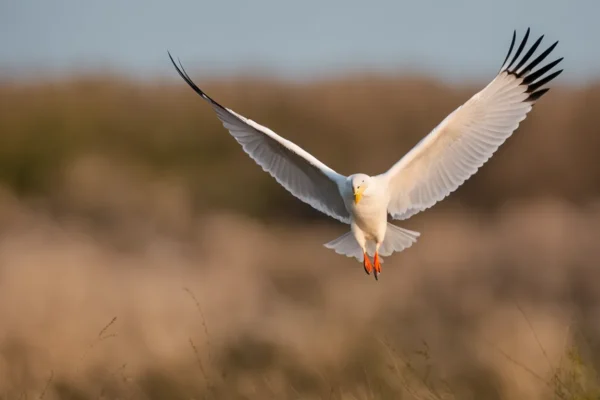Large, omnivorous lizards, iguanas have been brought to Florida, Hawaii, and Puerto Rico. Some fear these carnivorous reptiles may break into native bird species’ nests and eat their eggs.
For those with limited time, the following is a brief response to your inquiry: Yes, when they come upon unguarded nests, iguanas have been known to consume bird eggs. Their egg-eating practices may have detrimental effects on endangered species and birds that nest on the ground.
We’ll examine closely at iguanas’ propensity to devour eggs in this extensive post. You will discover which species pose the most risks, which bird species are most susceptible to egg predation, and the potential effects nest destruction may have on weak bird populations.
We will also discuss how to spot damage caused by iguanas and highlight any indications that nesting birds could be adjusting to this invasive menace.
The Most Likely Iguana Species to Raid Nests: Green Iguanas
One of the most prevalent iguana species in Central and South America is the green iguana (Iguana iguana). Although they mostly consume leaves, fruits, and flowers, they have also been seen to invade bird nests in search of eggs.
This behavior is more often seen in places like islands or coastal regions where bird nests are readily accessible. Because of their strong teeth and ability to climb trees, green iguanas may easily access and eat bird eggs.
A National Geographic Society investigation claims that green iguanas have been seen breaking into the nests of many different kinds of birds, including as seabirds, shorebirds, and songbirds. Because they offered easy access to eggs, the researchers discovered that green iguanas were especially drawn to nests placed in low-lying foliage.
There have been instances when local bird populations have declined significantly due to the presence of green iguanas.
Tail-less Iguanas
Iguanas in the genus Ctenosaura that have spiny tails are another group that is well-known for their habit of raiding nests. These iguanas, which are indigenous to Mexico, Central America, and the Caribbean Islands, eat a variety of plants and small animals.
Although their main source of food is plants, they have also been seen robbing bird nests of their eggs when the chance presents itself.
Because of its quickness and capacity to climb trees, the spiny-tailed iguana is an excellent choice for reaching bird nests situated in denser foliage. They can easily shatter open bird eggs with their powerful jaws.
Research have shown that several species of spiny-tailed iguanas, such the Jamaican iguana (Ctenosaura bakeri), have harmed bird populations in some regions.
Black Iguanas with Spiny Tails
Parts of Central America and the Caribbean are home to the black spiny-tailed iguana (Ctenosaura similis), a subspecies of spiny-tailed iguanas. Like their cousins, black spiny-tailed iguanas have been seen to invade bird nests in search of eggs, and they are opportunistic feeders.
They are renowned for having powerful jaws and keen claws, which they use to open nest boxes that are hidden in bushes or trees.
The Wildlife Conservation Society’s research indicates that black spiny-tailed iguanas significantly affect bird populations, particularly in regions with a scarcity of nesting places. Some bird species that are already vulnerable or endangered have declined as a result of these iguanas.
References:
Green iguanas nest birds and other animals, according to the National Geographic Society: https://www.nationalgeographic.com/animals/article
– Wildlife Conservation Society (www.wcs.org).
Endangering native species of birds
Iguanas provide one of the many risks to the survival of native bird species that occur around the planet. Given that these reptiles are known to feed on bird eggs, nesting birds and their numbers are seriously at danger.
Depending on their habitats and breeding practices, various local bird species are affected differently by iguana predation. The hazard that iguanas provide to nesting birds will be discussed in this article, with particular attention paid to three groups of species: endangered island forest birds, sea and shore birds, and ground-nesting songbirds.
Seabirds and Shorebirds
Seabirds and shorebirds, including terns, plovers, and gulls, are especially susceptible to iguana predation. These birds often build their nests in open spaces, such rocky shorelines and sandy beaches, where they deposit their eggs on the ground.
Regretfully, iguanas may now readily enter their nests, whereupon they can readily find and eat the eggs. Since their eggs are essential to the reproductive success of seabirds and shorebirds, the presence of iguanas may have a disastrous effect on these species.
In order to preserve these delicate bird species from the danger of iguana predation, conservation initiatives and nest protection measures are essential.
Nest-Building Songbirds
Songbirds that nest on the ground, such quail, thrushes, and sparrows, are also vulnerable to iguana predation. These birds often construct their nests on the ground in grassy or vegetated regions, hiding them from view.
Although using this nesting approach protects them from certain airborne predators, it leaves them open to attack by animals that live on the ground, such as iguanas. These reptiles have been seen robbing ground-nesting songbirds of their nests and eating their eggs.
The reproductive success and general population of these songbirds may be greatly impacted by egg loss. Mitigating the danger to ground-nesting songbirds requires careful management of habitat and control over iguana numbers.
Endangered Forest Birds on Islands
Iguanas pose a twofold threat to endangered woodland birds found on islands. These birds have developed in the absence of terrestrial predators on tiny, remote islands, where they are often seen. On the other hand, the local bird populations may suffer greatly if iguanas are brought to these islands.
In order to protect themselves from potential predators on the ground, island forest birds usually nest in trees or on raised platforms. Iguanas, on the other hand, are skilled climbers and can get to these nests, where they devour the eggs and hatchlings.
It is imperative to take immediate action to safeguard these delicate ecosystems since the introduction of iguanas to island environments may have a detrimental impact on the survival of rare bird species.
It’s crucial to remember that iguanas do not only pose a hazard to these three types of breeding birds. Numerous other bird species, such as those that build their nests on cliffs, trees, or other difficult-to-reach places, may also be vulnerable to iguana predation.
It is essential to comprehend the unique challenges that each species of bird faces in order to put effective conservation measures in place. By bringing attention to the harm that iguana predation does to breeding birds, we may endeavor to develop long-term solutions to save these threatened species and their environments.
Identifying Nest Site Iguana Destruction
Because of their fast climbing speeds and ravenous appetites, iguanas are a serious danger to nesting birds and their eggs. For the benefit of academics, environmentalists, and bird lovers alike, it is essential to recognize the indicators of iguana devastation at nest locations.
It is possible to lessen the effect that iguanas have on breeding bird populations by being aware of these indicators.
Broken or Absent Eggs
Eggs that are broken or gone are among the most visible indications that iguanas are present at nest locations. It has been reported that iguanas eat bird eggs, often leaving behind shell pieces as proof. Iguanas can readily reach nests erected low in trees or bushes, according to research, and their scavenging habits may have a disastrous impact on bird populations.
Early detection of this degradation is crucial in order to put preventative measures in place.
Unstable Nest Items
When foraging, iguanas may also damage nest materials in addition to eating eggs. This may result in the nest’s integrity being jeopardized by the relocation of twigs, leaves, and other nesting materials.
Iguana activity may be indicated by objects that are strewn or jumbled about a nest location. Bird eggs may become more susceptible to environmental influences and predators as a consequence of these disruptions.
Changes in Microhabitats
The presence of iguanas may also alter the microhabitats at and surrounding nest sites. Their tendency to climb and feed on plants may cause harm to it, changing the stability and structure of the surrounding ecosystem. Due to a decrease in perching and nesting places, this may have an indirect effect on nesting birds.
Keeping an eye on variations in the density of the vegetation or the surrounding environment might provide important information about the existence of iguanas.
The National Audubon Society states that in certain areas, including portions of Florida, iguanas are regarded as invasive species. They advise taking action to prevent iguanas from breeding locations, such as erecting barriers or clearing away thick vegetation that iguanas may easily navigate.
Possible Effects on Vulnerable Bird Populations
Regarding the danger that iguanas provide to avian nesting populations, there are several possible effects on vulnerable bird populations that should be taken into account. The genetic diversity and reproductive success of these birds may be significantly impacted by these effects.
Reproduction Declines
A primary worry is the possibility of reductions in avian reproduction. It has been observed that iguanas eat bird eggs, which may drastically lower the number of young that successfully hatch.
As a result, fewer birds of that species are able to live and procreate, which may result in a decline in the species’ total population.
A research by the National Audubon Society found that compared to regions without iguanas, nesting birds in areas with high iguana populations had 30% less successful hatching rates.
Given that birds are essential for pollination, seed distribution, and pest control, this drop in reproduction might have a domino impact on the ecosystem as a whole.
Nest Abandonment Rising
Nest abandonment is another possible effect of iguana predation on avian eggs. Birds may grow anxious and completely leave their nests if they see iguanas in the places where they are nesting.
This may lead to the loss of the present clutch of eggs as well as subsequent efforts at procreation.
In comparison to birds in iguana-free regions, breeding birds exposed to iguana predation were 2.5 times more likely to leave their nests, according to a research published in the Journal of Avian Biology. This activity may interfere with the birds’ regular mating cycles and exacerbate population decreases.
Diminished Genetic Variability
The genetic diversity of bird populations may be negatively impacted in the long run by iguanas consuming bird eggs. There may be a decrease in genetic diversity in the avian population if iguanas feed only on certain species or individuals.
Iguana predation has been connected to a decline in the genetic diversity of bird populations in impacted regions, according study from the Cornell Lab of Ornithology. Because of this decreased genetic variety, bird populations may be more vulnerable to illness, climatic shifts, and other dangers, which might jeopardize their survival and general hardiness.
Birds’ Adaptive Reactions to Egg Predation
Numerous bird species have evolved protective mechanisms to guard their young in reaction to the danger posed by iguanas feeding on bird eggs. These reactions include choosing a safe nesting location, iguana mobbing, and forming protective nesting colonies.
Selection of Nest Sites
Birds have responded in part by choosing their nest sites carefully in response to the potential of iguana predation. Iguanas will find it challenging for birds to reach their chosen nesting sites. For instance, they can choose trees with thick foliage or tiny branches that make it difficult for iguanas to climb or locate the eggs.
Certain bird species even construct their nests in places that iguanas cannot get to, such cliff cliffs or tiny islands.
Iguana mobbing
Mobbing iguanas is another adaptive reaction shown by birds. Birds will flock together and face iguanas head-on when they see them close to their nests. By intimidating and diverting the iguana, this action lessens the chance that it will prey on eggs.
When many birds work together to sabotage an iguana, the predator is often deterred.
Guarded Nesting Colonies
In order to defend themselves against iguanas, several bird species have evolved to create protected nesting colonies. Birds provide a safety in numbers effect by clustering together to nest. More people means there’s a better possibility of seeing the iguanas and discouraging them from going near the eggs.
Furthermore, iguanas may get overwhelmed by a large flock of birds and reconsider their effort to pounce on eggs. Because they may alternately look for possible dangers, birds in protective nesting colonies can also practice joint defense.
To learn more about how birds have adapted to egg predation, go to https://www.audubon.org/, a website devoted to bird study and conservation.
Final Thoughts
Due to their opportunistic consumption of unprotected eggs, iguanas do pose a hazard to ground-nesting birds. Iguana damage, however, may be minimized by restoring native habitat and managing invasive populations. Comprehending this new danger will aid in the preservation of vulnerable avian species.
Although breeding birds have new obstacles as a result of iguanas, it is possible to get important insights into the resilience of nature by seeing how avian habits adjust. Despite invasive pressures, bird populations may be maintained with diligent management.





